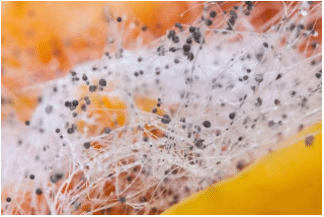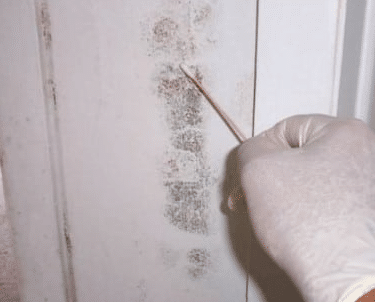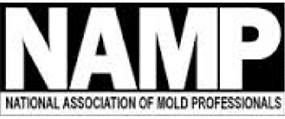
When it comes to mold, it’s often the most dangerous where you can’t see it. Tucked away in a crawl space or a wall cavity of your home, mold growth can go unnoticed for a long time. The longer it goes undetected, the more likely it is to cause serious structural damage to your property. But the biggest threat is the invisible mold spores getting released into your indoor air supply. In terms of health risks, inhaling those spores can cause allergic reactions, headaches, and even contribute to memory loss or other lifelong medical conditions.
Considering the hefty risks involved, it’s no wonder smart property owners (like you) are researching how-to’s on air quality testing, the golden standard for detecting unsafe levels of mold. But before diving into the how, it’s important to start with the when.
When Should I Test for Mold in the Air?
The truth is not every mold issue calls for an air quality test. In fact, you should be wary of companies who tell you otherwise. They either don’t have the proper expertise or are trying to trick you into spending more money than you need to.
Here are 3 ways to gauge when you should test your air:
1) There is no visible mold, but there are other signs of mold in your property: According to the Environmental Protection Agency (EPA), mold testing doesn’t need to happen if you see obvious affected areas inside your property. That’s because the purpose of the test is to detect harmful levels of mold in the air. Here are some signs too look out for that may indicate you have an overgrowth that’s out of sight. The most common triggers to watch out for, include:
- A musty or stale smell
- Recent water damage or leaks
- Spongy or bouncy feeling floors
2) Someone is experiencing health issues commonly caused by mold: Another reason to prioritize air testing is when someone spending time inside your property experiences certain health issues, but the cause is unclear. Again, this only applies if you have not uncovered visible signs of mold already. Check out this infographic via the Military Health system for common symptoms to watch out for.

3) You recently removed/remediated mold in your property: The best way to find out if you eliminated harmful mold in your property is by testing the air. If you’re looking for confirmation that your recent mold removal or remediation project was effective, an air quality test will tell you exactly that (i.e., whether or not the mold levels in your property have returned to safe levels).
How Should I Test the Air for Mold?
Now that you know when you do (or don’t) need to test your air for mold, let’s get to the how. As we mentioned earlier, air testing is a “golden standard” for detecting exposure to harmful levels of mold. Indeed, compared to other methods (e.g., surface testing), it can produce the most accurate results but only when done right. A test’s accuracy depends entirely on three things: how the test is conducted, how the samples are analyzed, and how the results are interpreted. In a nutshell, it all comes down to your decision on who will be doing each of these steps. Let’s break down your options and what we recommend for getting the most reliable results.
1) DIY Air Testing Kit vs. Professional Mold Testing: As a property owner, one of the first things you’re probably wondering is: do I need to hire a professional or can I save money and do-it-myself? It’s a fair question, especially because hiring a mold testing company isn’t cheap. DIY is certainly an option, and there are plenty of home test kits for sale in stores and online, along with tutorials galore on how to do all three steps  referenced above. But there’s a catch. If you’re looking for definitive answers on whether or not you have harmful levels of mold in the air, where it’s coming from, and what’s causing it, then DIY is probably not the way to go. Here’s why:
referenced above. But there’s a catch. If you’re looking for definitive answers on whether or not you have harmful levels of mold in the air, where it’s coming from, and what’s causing it, then DIY is probably not the way to go. Here’s why:
- The Skinny on DIY: Mold is always present in your property; what you’re testing for is elevated levels of mold spores that create unsafe, hazardous conditions. With a home test kit, you’re less likely to get precise measurements on the actual amount of mold in the air, which can lead to inconclusive results, and make it extremely tough to determine whether or not your level of mold is dangerous or totally normal. There’s also the added cost (and waiting time) you’ll need to factor in for sending your samples to a lab. If you’re hoping for a quick day-long project, this isn’t it.
- Why a Pro is Worth the $$: When you hire a pro, they rely on far more than just the results of the actual air test. For example, they will do a visual inspection of your property and use their knowledge/experience to locate hidden mold growth and the moisture source causing it. It goes without saying that the testing equipment used by a company is far more advanced and accurate than any home test you can buy. Last, but definitely not least, a trained professional is critical when it comes to interpreting the results, which require expertise to translate and offer effective recommendations.
2) Underqualified/Scam Companies vs. Trained Mold Experts: Perhaps we’ve convinced you to forgo DIY and opt to hire a mold testing company.  Before you go ahead, there’s a couple of things you’ll need to know. The mold business may be bigger than you think, and unfortunately, not every contractor/company has the qualifications and training they need to deliver results you can count on. Here are three you should keep in your back pocket to ensure your hire highly qualified, reliable pros (via Today’s Homeowner):
Before you go ahead, there’s a couple of things you’ll need to know. The mold business may be bigger than you think, and unfortunately, not every contractor/company has the qualifications and training they need to deliver results you can count on. Here are three you should keep in your back pocket to ensure your hire highly qualified, reliable pros (via Today’s Homeowner):
- Mold Inspection License: While there is no official government certifications or credentials for a mold inspector, you should hire someone who holds a general contractor license.
- 100% Free Mold Inspections/Testing: As we discussed above, mold testing isn’t a quick and easy job. It takes time, equipment, and trained professionals. Be wary of companies offering free inspection or testing services as they may only be using it to trick you into buy their services (even if you don’t actually need mold removal/remediation).
- Watch out for Scammer Behavior: Imposter companies may take measures aiming to increase the presence of mold spores during the test (e.g., turn up the heat in your property or mess with your furniture trying to release extra spores into the air).
Want a 100% Free Estimate for Your Mold Air Test?
Now that you know when/how to do an initial air test and when to hire a professional company, you’re ready to take the next step. The team at Mold Gone wants to help make things as stress-free as possible by providing you with a free estimate for your indoor air quality testing needs.
Why Choose Mold Gone for Your Mold Testing/Removal Project?
We know there are a lot of mold testing and removal companies for you to choose from in the DC/MD/VA area. Here’s why you’ll get the best possible results for your money by choosing Mold Gone:


Visit our Indoor Air Quality Testing page for more on how our proven process and dedicated experts ensure all hazardous mold in your property is uncovered and can help you get rid of it for good!


Trackbacks/Pingbacks